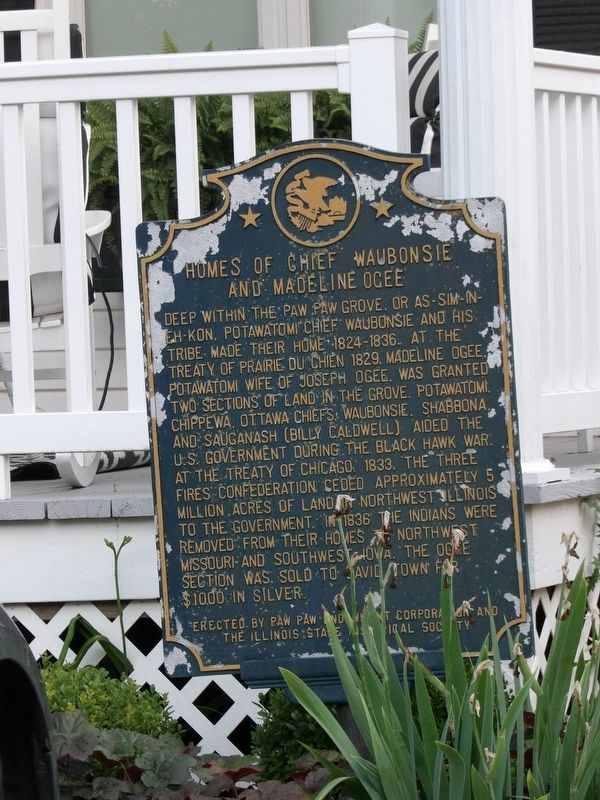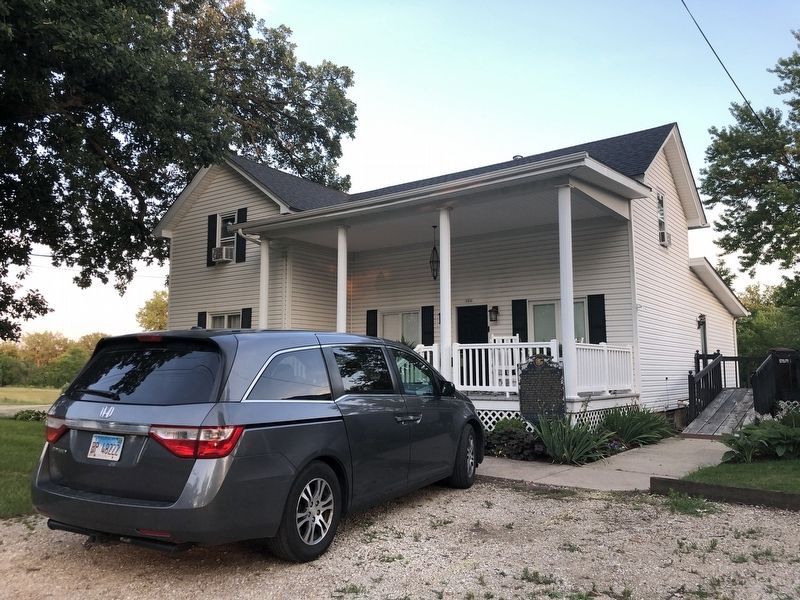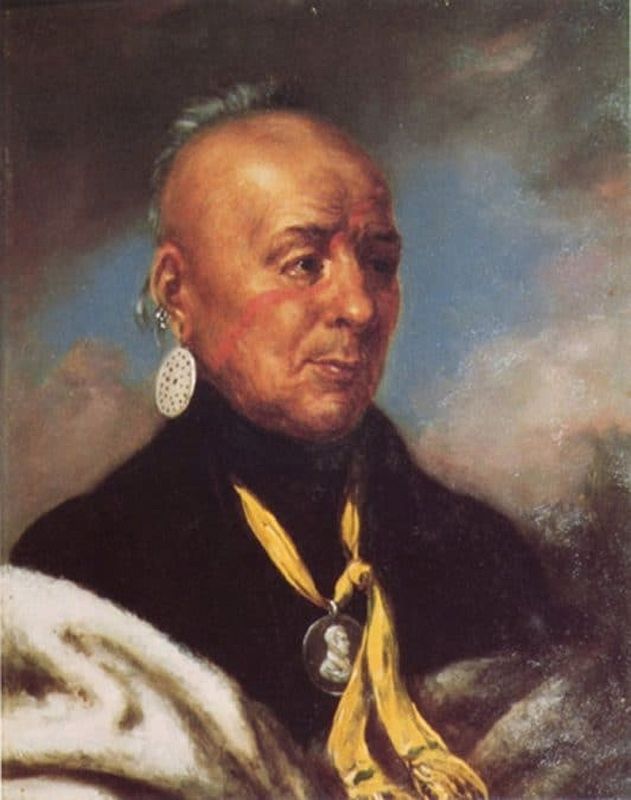Paw Paw in Lee County, Illinois — The American Midwest (Great Lakes)
Homes of Chief Waubonsie and Madeline Ogee
Inscription.
Deep within the Paw Paw Grove, or As-Sim-In-Eh-Kon, Potawatomi Chief Waubonsie and his tribe made their home 1824-1836. At the Treaty of Prairie Du Chien 1829, Madeline Ogee, Potawatomi wife of Joseph Ogee, was granted two sections of land in the grove. Potawatomi, Chippewa, Ottawa Chiefs, Waubonsie, Shabbona, and Sauganash (Billy Caldwell) aided the U.S. Government during the Black Hawk War. At the Treaty of Chicago, 1833, the Three Fires Confederation ceded approximately 5 million acres of land in northwest Illinois to the government. In 1836 the Indians were removed from their homes to northwest Missouri and southwest Iowa. The Ogee section was sold to David Town for $1000 in silver.
Topics and series. This historical marker is listed in these topic lists: Native Americans • Wars, US Indian. In addition, it is included in the Illinois State Historical Society series list. A significant historical year for this entry is 1829.
Location. 41° 41.134′ N, 88° 58.726′ W. Marker is in Paw Paw, Illinois, in Lee County. Marker is at the intersection of Wheeler Street and Chapman Street, on the right when traveling east on Wheeler Street. Touch for map. Marker is at or near this postal address: 205 Wheeler St, Paw Paw IL 61353, United States of America. Touch for directions.
Other nearby markers. At least 4 other markers are within 12 miles of this marker, measured as the crow flies . Old Chicago Trail (approx. half a mile away); Chief Shabbona (approx. 8.1 miles away); Shabbona (approx. 8.3 miles away); Railroads and the Founding of Mendota (approx. 11.8 miles away).
Regarding Homes of Chief Waubonsie and Madeline Ogee. From the Smithsonian:
The Prairie du Chien Treaty was one of 12 major treaties in which Potawatomi people relinquished most of their land in the southern Great Lakes to the United States. During the treaty negotiations at Prairie du Chien, Wisconsin, in 1829, U.S. officials pressured Native leaders to cede territories in northern Illinois and southwestern Wisconsin, parts of which were already occupied by American intruders. Ultimately, 35 tribal representatives signed the treaty, including five women who are thought to be widows or heirs of deceased chiefs. Under the agreement, Potawatomi and associated Ottawa and Ojibwe groups relinquished 3.5 million acres of tribal land. In return, the U.S. government exchanged trade goods, barrels of salt, annual payments in silver, a blacksmith shop in Chicago and land parcels for tribal leaders and their Indigenous-French (Métis) descendants, and $11,601 was set aside to settle Native American debts to traders. The treaty furthered the U.S. government’s gradual removal of the Potawatomi people to lands west of the Mississippi River.
Also see . . .
1. The Life of Wah-bahn-se: The Warrior Chief of the Pottawatamies. Transcript of biography that first appeared in the Kansas City (Mo.) Enterprise in 1857 and was reprinted in the Kansas Historical Quarterly in 1972. The writer, Joseph Napoleon Bourassa, was Potawatomi. (Kansas Historical Society) (Submitted on August 15, 2023, by Duane and Tracy Marsteller of Murfreesboro, Tennessee.)
2. Potawatomi Leader Wabaunsee Remembered for His Prowess in Battle and Impact on 19th Century Indian. Wabaunsee, born Nakses, was a powerful and influential headman among the Potawatomi, Odawa and Ojibwe villages of Illinois and Indiana. ( Citizen Potawatomi Nation, posted Sept. 20, 2019) (Submitted on August 15, 2023, by Duane and Tracy Marsteller of Murfreesboro, Tennessee.)
3. 1833 Treaty of Chicago. Wikipedia entry on the treaty, in which the Chippewa, Odawa and Potawatomi tribes ceded the last of their lands in the state of Illinois and in the Michigan and Wisconsin territories. (Submitted on August 15, 2023, by Duane and Tracy Marsteller of Murfreesboro, Tennessee.)
Credits. This page was last revised on August 15, 2023. It was originally submitted on August 15, 2023, by Duane and Tracy Marsteller of Murfreesboro, Tennessee. This page has been viewed 142 times since then and 67 times this year. Photos: 1, 2, 3. submitted on August 15, 2023, by Duane and Tracy Marsteller of Murfreesboro, Tennessee.


